Leadership, Management Styles, and Communication in Hospitality
VerifiedAdded on 2020/01/16
|20
|4902
|175
Report
AI Summary
This report delves into the core aspects of leadership and management within the hospitality sector, using the Marriott and Hilton hotels as case studies. It explores diverse management styles, including scientific, systems, and human relationship approaches, and evaluates leadership characteristics such as autocratic, democratic, and bureaucratic styles. The report also assesses communication processes within these organizations, highlighting the use of written and verbal communication methods. Furthermore, it examines organizational culture, encompassing power and role cultures, and discusses strategies for team leadership and motivation to achieve targets. The report concludes with a self-assessment of managerial skills and a personal development plan, providing a comprehensive overview of effective management practices in the hospitality industry.
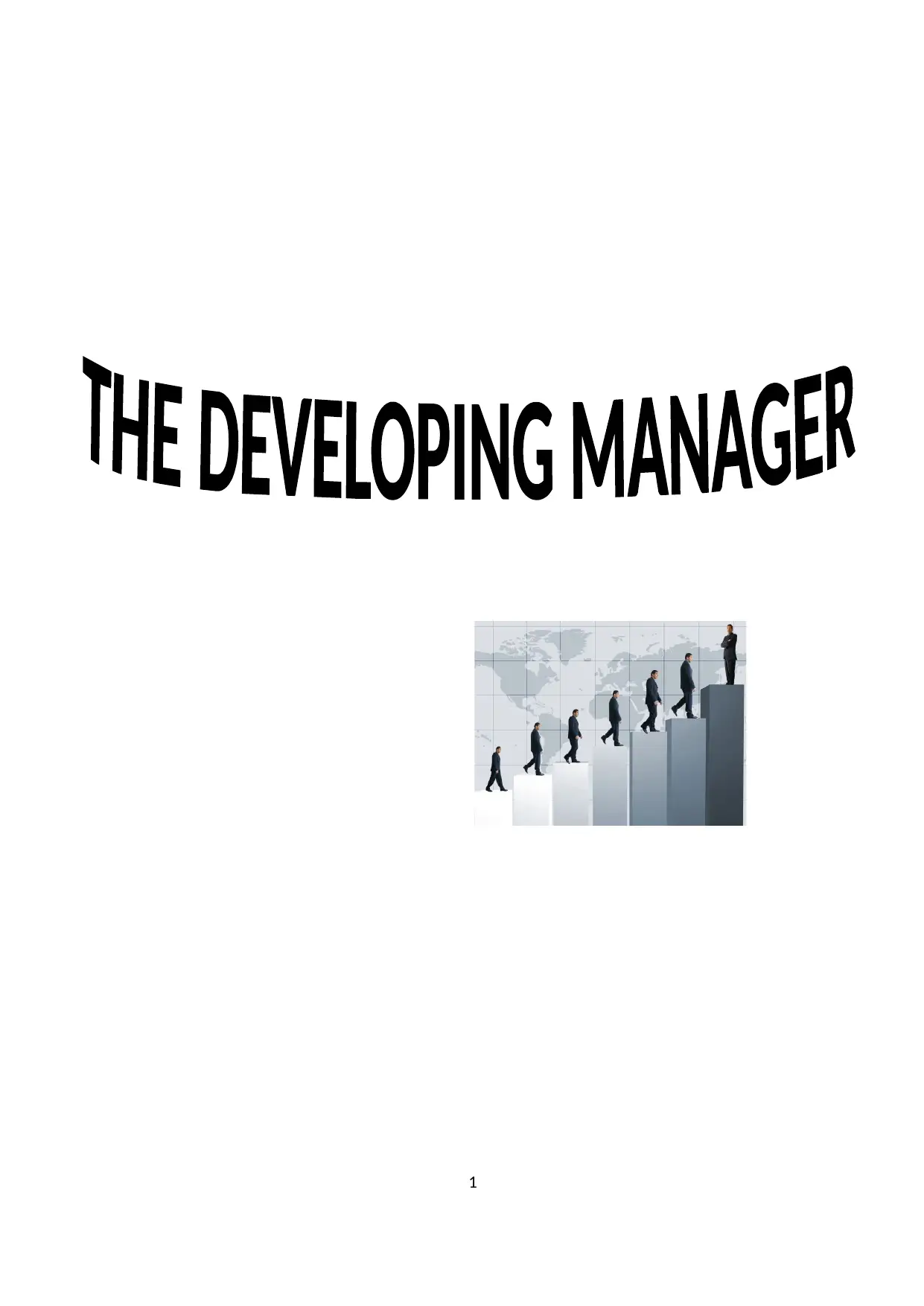
1
Paraphrase This Document
Need a fresh take? Get an instant paraphrase of this document with our AI Paraphraser
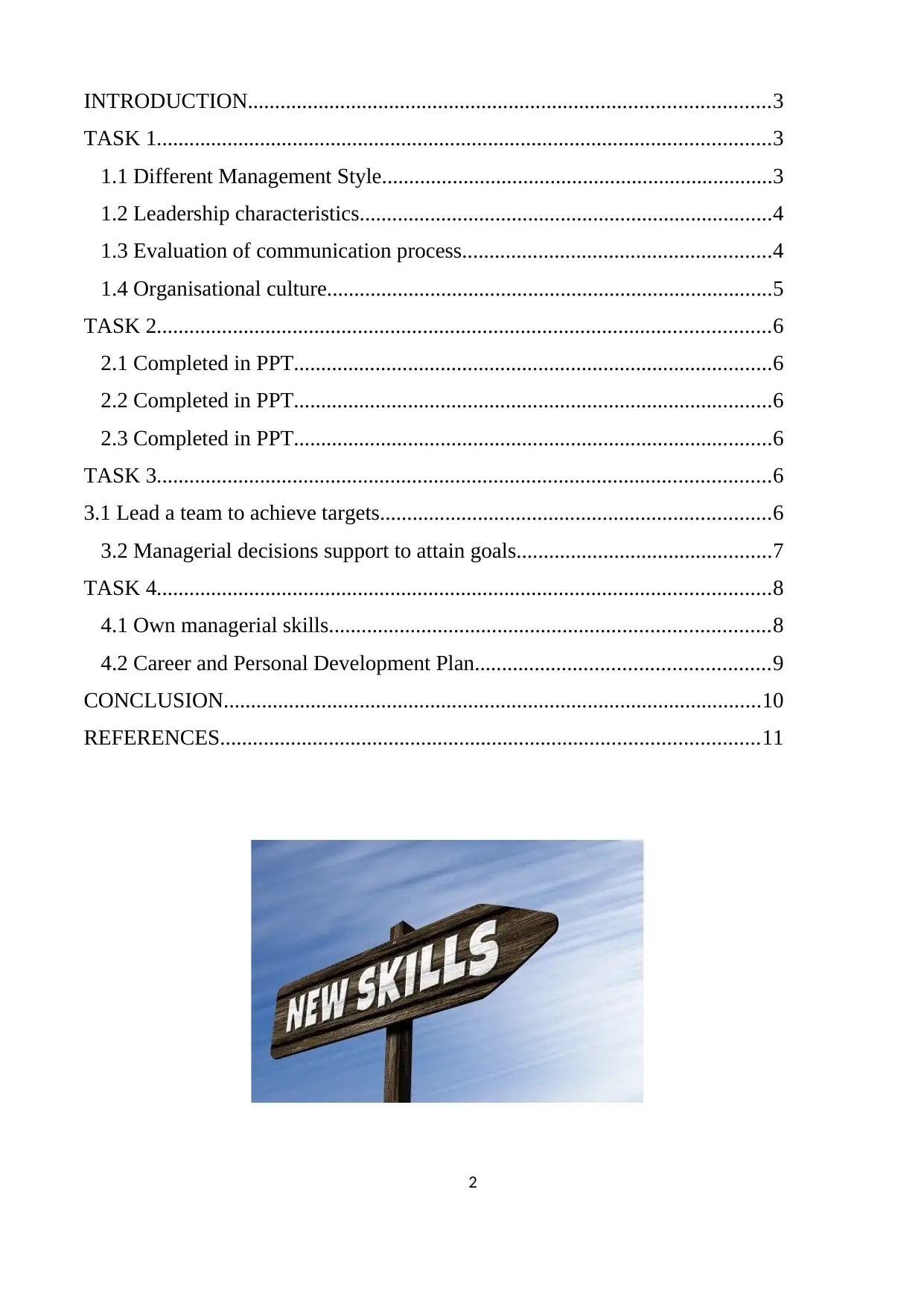
INTRODUCTION................................................................................................3
TASK 1.................................................................................................................3
1.1 Different Management Style........................................................................3
1.2 Leadership characteristics............................................................................4
1.3 Evaluation of communication process.........................................................4
1.4 Organisational culture..................................................................................5
TASK 2.................................................................................................................6
2.1 Completed in PPT........................................................................................6
2.2 Completed in PPT........................................................................................6
2.3 Completed in PPT........................................................................................6
TASK 3.................................................................................................................6
3.1 Lead a team to achieve targets........................................................................6
3.2 Managerial decisions support to attain goals...............................................7
TASK 4.................................................................................................................8
4.1 Own managerial skills.................................................................................8
4.2 Career and Personal Development Plan......................................................9
CONCLUSION...................................................................................................10
REFERENCES...................................................................................................11
2
TASK 1.................................................................................................................3
1.1 Different Management Style........................................................................3
1.2 Leadership characteristics............................................................................4
1.3 Evaluation of communication process.........................................................4
1.4 Organisational culture..................................................................................5
TASK 2.................................................................................................................6
2.1 Completed in PPT........................................................................................6
2.2 Completed in PPT........................................................................................6
2.3 Completed in PPT........................................................................................6
TASK 3.................................................................................................................6
3.1 Lead a team to achieve targets........................................................................6
3.2 Managerial decisions support to attain goals...............................................7
TASK 4.................................................................................................................8
4.1 Own managerial skills.................................................................................8
4.2 Career and Personal Development Plan......................................................9
CONCLUSION...................................................................................................10
REFERENCES...................................................................................................11
2
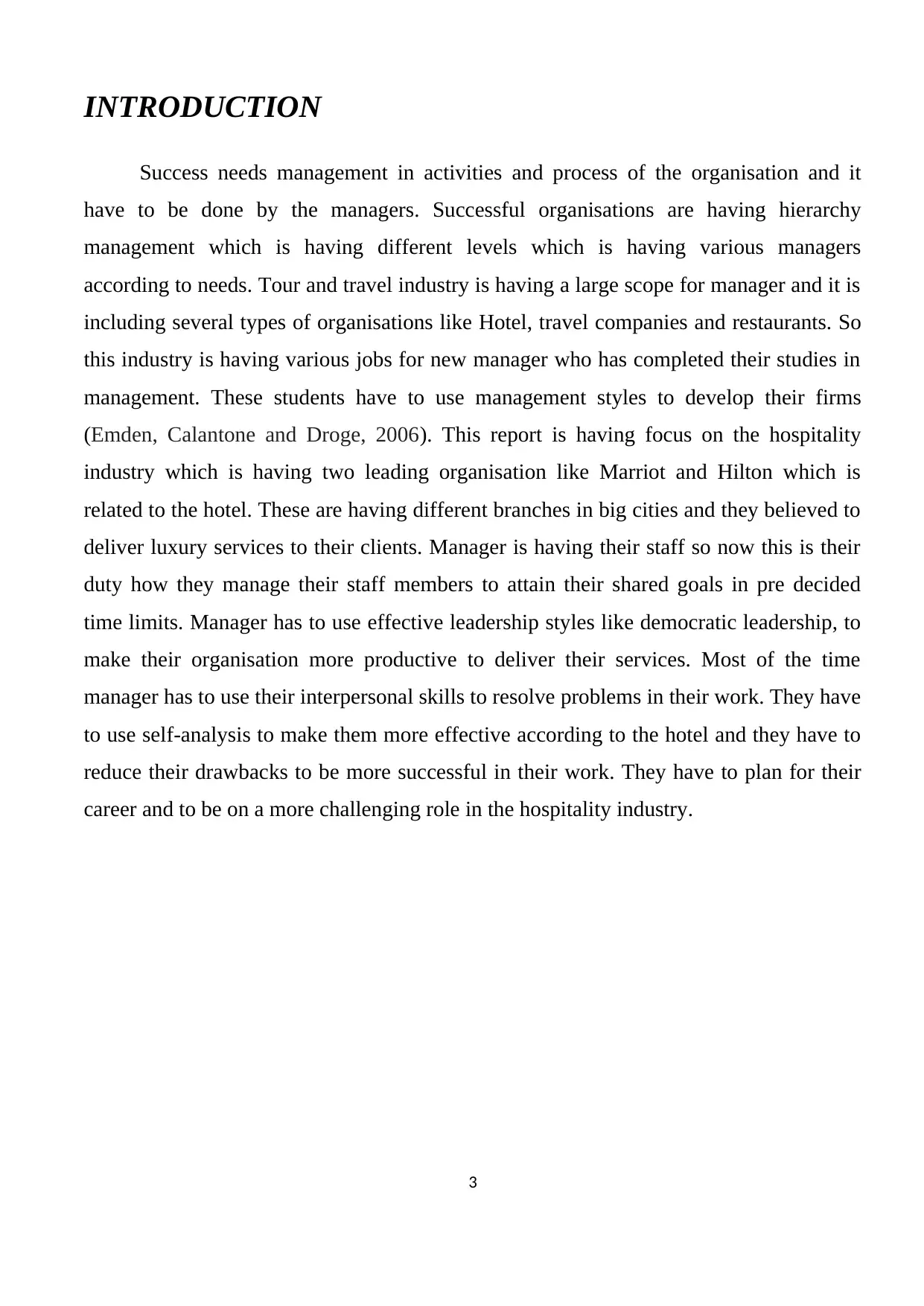
INTRODUCTION
Success needs management in activities and process of the organisation and it
have to be done by the managers. Successful organisations are having hierarchy
management which is having different levels which is having various managers
according to needs. Tour and travel industry is having a large scope for manager and it is
including several types of organisations like Hotel, travel companies and restaurants. So
this industry is having various jobs for new manager who has completed their studies in
management. These students have to use management styles to develop their firms
(Emden, Calantone and Droge, 2006). This report is having focus on the hospitality
industry which is having two leading organisation like Marriot and Hilton which is
related to the hotel. These are having different branches in big cities and they believed to
deliver luxury services to their clients. Manager is having their staff so now this is their
duty how they manage their staff members to attain their shared goals in pre decided
time limits. Manager has to use effective leadership styles like democratic leadership, to
make their organisation more productive to deliver their services. Most of the time
manager has to use their interpersonal skills to resolve problems in their work. They have
to use self-analysis to make them more effective according to the hotel and they have to
reduce their drawbacks to be more successful in their work. They have to plan for their
career and to be on a more challenging role in the hospitality industry.
3
Success needs management in activities and process of the organisation and it
have to be done by the managers. Successful organisations are having hierarchy
management which is having different levels which is having various managers
according to needs. Tour and travel industry is having a large scope for manager and it is
including several types of organisations like Hotel, travel companies and restaurants. So
this industry is having various jobs for new manager who has completed their studies in
management. These students have to use management styles to develop their firms
(Emden, Calantone and Droge, 2006). This report is having focus on the hospitality
industry which is having two leading organisation like Marriot and Hilton which is
related to the hotel. These are having different branches in big cities and they believed to
deliver luxury services to their clients. Manager is having their staff so now this is their
duty how they manage their staff members to attain their shared goals in pre decided
time limits. Manager has to use effective leadership styles like democratic leadership, to
make their organisation more productive to deliver their services. Most of the time
manager has to use their interpersonal skills to resolve problems in their work. They have
to use self-analysis to make them more effective according to the hotel and they have to
reduce their drawbacks to be more successful in their work. They have to plan for their
career and to be on a more challenging role in the hospitality industry.
3
⊘ This is a preview!⊘
Do you want full access?
Subscribe today to unlock all pages.

Trusted by 1+ million students worldwide
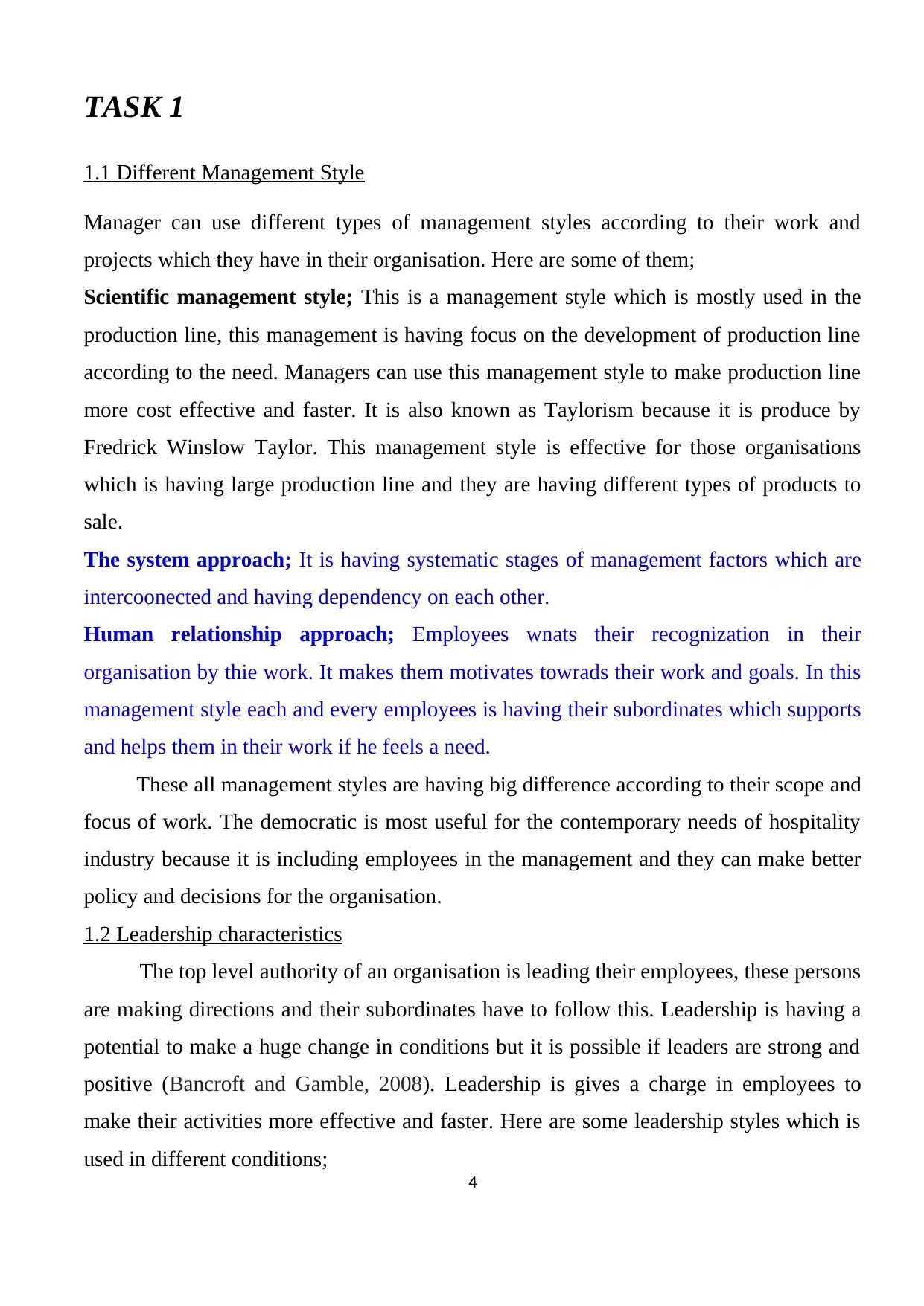
TASK 1
1.1 Different Management Style
Manager can use different types of management styles according to their work and
projects which they have in their organisation. Here are some of them;
Scientific management style; This is a management style which is mostly used in the
production line, this management is having focus on the development of production line
according to the need. Managers can use this management style to make production line
more cost effective and faster. It is also known as Taylorism because it is produce by
Fredrick Winslow Taylor. This management style is effective for those organisations
which is having large production line and they are having different types of products to
sale.
The system approach; It is having systematic stages of management factors which are
intercoonected and having dependency on each other.
Human relationship approach; Employees wnats their recognization in their
organisation by thie work. It makes them motivates towrads their work and goals. In this
management style each and every employees is having their subordinates which supports
and helps them in their work if he feels a need.
These all management styles are having big difference according to their scope and
focus of work. The democratic is most useful for the contemporary needs of hospitality
industry because it is including employees in the management and they can make better
policy and decisions for the organisation.
1.2 Leadership characteristics
The top level authority of an organisation is leading their employees, these persons
are making directions and their subordinates have to follow this. Leadership is having a
potential to make a huge change in conditions but it is possible if leaders are strong and
positive (Bancroft and Gamble, 2008). Leadership is gives a charge in employees to
make their activities more effective and faster. Here are some leadership styles which is
used in different conditions;
4
1.1 Different Management Style
Manager can use different types of management styles according to their work and
projects which they have in their organisation. Here are some of them;
Scientific management style; This is a management style which is mostly used in the
production line, this management is having focus on the development of production line
according to the need. Managers can use this management style to make production line
more cost effective and faster. It is also known as Taylorism because it is produce by
Fredrick Winslow Taylor. This management style is effective for those organisations
which is having large production line and they are having different types of products to
sale.
The system approach; It is having systematic stages of management factors which are
intercoonected and having dependency on each other.
Human relationship approach; Employees wnats their recognization in their
organisation by thie work. It makes them motivates towrads their work and goals. In this
management style each and every employees is having their subordinates which supports
and helps them in their work if he feels a need.
These all management styles are having big difference according to their scope and
focus of work. The democratic is most useful for the contemporary needs of hospitality
industry because it is including employees in the management and they can make better
policy and decisions for the organisation.
1.2 Leadership characteristics
The top level authority of an organisation is leading their employees, these persons
are making directions and their subordinates have to follow this. Leadership is having a
potential to make a huge change in conditions but it is possible if leaders are strong and
positive (Bancroft and Gamble, 2008). Leadership is gives a charge in employees to
make their activities more effective and faster. Here are some leadership styles which is
used in different conditions;
4
Paraphrase This Document
Need a fresh take? Get an instant paraphrase of this document with our AI Paraphraser
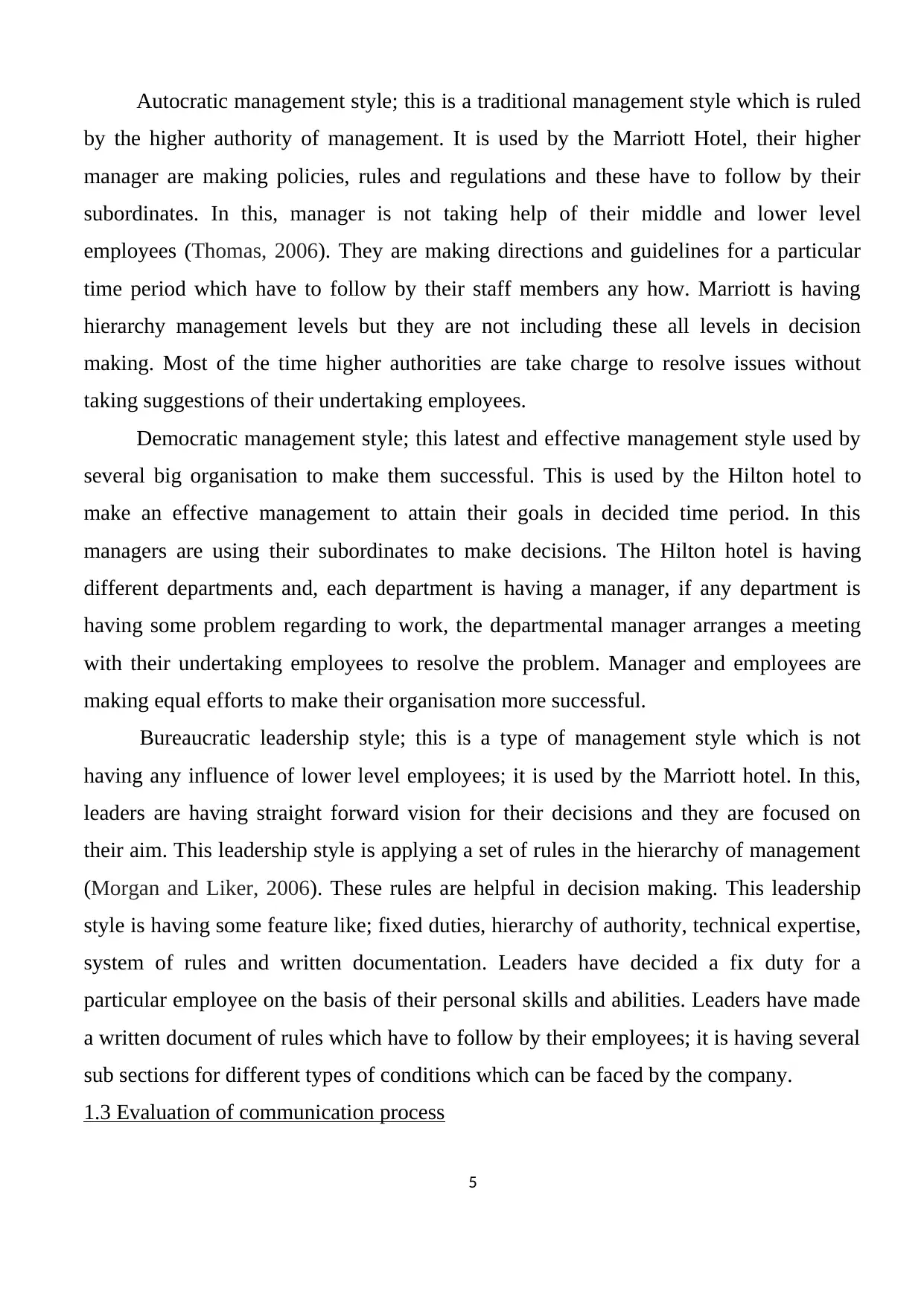
Autocratic management style; this is a traditional management style which is ruled
by the higher authority of management. It is used by the Marriott Hotel, their higher
manager are making policies, rules and regulations and these have to follow by their
subordinates. In this, manager is not taking help of their middle and lower level
employees (Thomas, 2006). They are making directions and guidelines for a particular
time period which have to follow by their staff members any how. Marriott is having
hierarchy management levels but they are not including these all levels in decision
making. Most of the time higher authorities are take charge to resolve issues without
taking suggestions of their undertaking employees.
Democratic management style; this latest and effective management style used by
several big organisation to make them successful. This is used by the Hilton hotel to
make an effective management to attain their goals in decided time period. In this
managers are using their subordinates to make decisions. The Hilton hotel is having
different departments and, each department is having a manager, if any department is
having some problem regarding to work, the departmental manager arranges a meeting
with their undertaking employees to resolve the problem. Manager and employees are
making equal efforts to make their organisation more successful.
Bureaucratic leadership style; this is a type of management style which is not
having any influence of lower level employees; it is used by the Marriott hotel. In this,
leaders are having straight forward vision for their decisions and they are focused on
their aim. This leadership style is applying a set of rules in the hierarchy of management
(Morgan and Liker, 2006). These rules are helpful in decision making. This leadership
style is having some feature like; fixed duties, hierarchy of authority, technical expertise,
system of rules and written documentation. Leaders have decided a fix duty for a
particular employee on the basis of their personal skills and abilities. Leaders have made
a written document of rules which have to follow by their employees; it is having several
sub sections for different types of conditions which can be faced by the company.
1.3 Evaluation of communication process
5
by the higher authority of management. It is used by the Marriott Hotel, their higher
manager are making policies, rules and regulations and these have to follow by their
subordinates. In this, manager is not taking help of their middle and lower level
employees (Thomas, 2006). They are making directions and guidelines for a particular
time period which have to follow by their staff members any how. Marriott is having
hierarchy management levels but they are not including these all levels in decision
making. Most of the time higher authorities are take charge to resolve issues without
taking suggestions of their undertaking employees.
Democratic management style; this latest and effective management style used by
several big organisation to make them successful. This is used by the Hilton hotel to
make an effective management to attain their goals in decided time period. In this
managers are using their subordinates to make decisions. The Hilton hotel is having
different departments and, each department is having a manager, if any department is
having some problem regarding to work, the departmental manager arranges a meeting
with their undertaking employees to resolve the problem. Manager and employees are
making equal efforts to make their organisation more successful.
Bureaucratic leadership style; this is a type of management style which is not
having any influence of lower level employees; it is used by the Marriott hotel. In this,
leaders are having straight forward vision for their decisions and they are focused on
their aim. This leadership style is applying a set of rules in the hierarchy of management
(Morgan and Liker, 2006). These rules are helpful in decision making. This leadership
style is having some feature like; fixed duties, hierarchy of authority, technical expertise,
system of rules and written documentation. Leaders have decided a fix duty for a
particular employee on the basis of their personal skills and abilities. Leaders have made
a written document of rules which have to follow by their employees; it is having several
sub sections for different types of conditions which can be faced by the company.
1.3 Evaluation of communication process
5
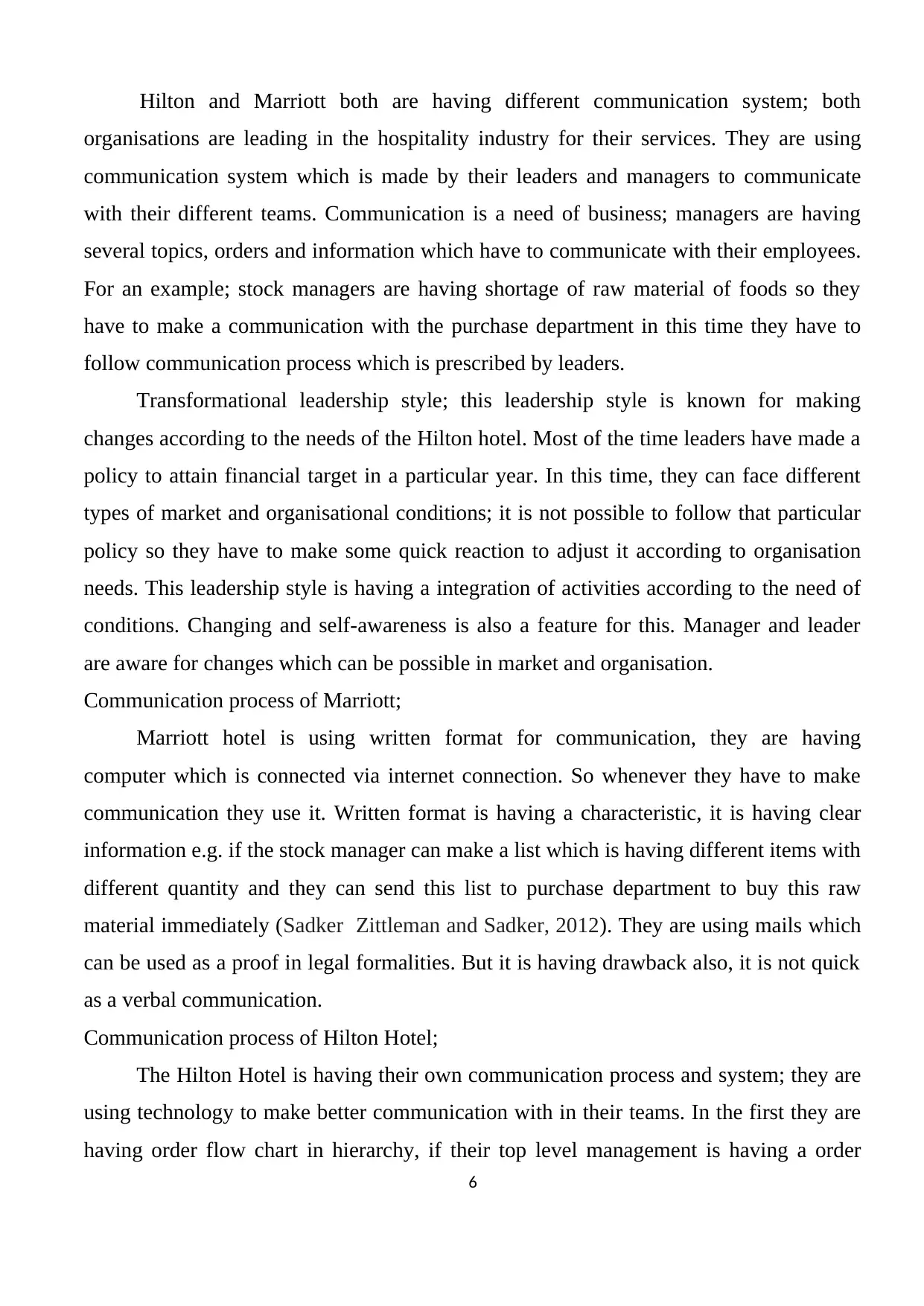
Hilton and Marriott both are having different communication system; both
organisations are leading in the hospitality industry for their services. They are using
communication system which is made by their leaders and managers to communicate
with their different teams. Communication is a need of business; managers are having
several topics, orders and information which have to communicate with their employees.
For an example; stock managers are having shortage of raw material of foods so they
have to make a communication with the purchase department in this time they have to
follow communication process which is prescribed by leaders.
Transformational leadership style; this leadership style is known for making
changes according to the needs of the Hilton hotel. Most of the time leaders have made a
policy to attain financial target in a particular year. In this time, they can face different
types of market and organisational conditions; it is not possible to follow that particular
policy so they have to make some quick reaction to adjust it according to organisation
needs. This leadership style is having a integration of activities according to the need of
conditions. Changing and self-awareness is also a feature for this. Manager and leader
are aware for changes which can be possible in market and organisation.
Communication process of Marriott;
Marriott hotel is using written format for communication, they are having
computer which is connected via internet connection. So whenever they have to make
communication they use it. Written format is having a characteristic, it is having clear
information e.g. if the stock manager can make a list which is having different items with
different quantity and they can send this list to purchase department to buy this raw
material immediately (Sadker Zittleman and Sadker, 2012). They are using mails which
can be used as a proof in legal formalities. But it is having drawback also, it is not quick
as a verbal communication.
Communication process of Hilton Hotel;
The Hilton Hotel is having their own communication process and system; they are
using technology to make better communication with in their teams. In the first they are
having order flow chart in hierarchy, if their top level management is having a order
6
organisations are leading in the hospitality industry for their services. They are using
communication system which is made by their leaders and managers to communicate
with their different teams. Communication is a need of business; managers are having
several topics, orders and information which have to communicate with their employees.
For an example; stock managers are having shortage of raw material of foods so they
have to make a communication with the purchase department in this time they have to
follow communication process which is prescribed by leaders.
Transformational leadership style; this leadership style is known for making
changes according to the needs of the Hilton hotel. Most of the time leaders have made a
policy to attain financial target in a particular year. In this time, they can face different
types of market and organisational conditions; it is not possible to follow that particular
policy so they have to make some quick reaction to adjust it according to organisation
needs. This leadership style is having a integration of activities according to the need of
conditions. Changing and self-awareness is also a feature for this. Manager and leader
are aware for changes which can be possible in market and organisation.
Communication process of Marriott;
Marriott hotel is using written format for communication, they are having
computer which is connected via internet connection. So whenever they have to make
communication they use it. Written format is having a characteristic, it is having clear
information e.g. if the stock manager can make a list which is having different items with
different quantity and they can send this list to purchase department to buy this raw
material immediately (Sadker Zittleman and Sadker, 2012). They are using mails which
can be used as a proof in legal formalities. But it is having drawback also, it is not quick
as a verbal communication.
Communication process of Hilton Hotel;
The Hilton Hotel is having their own communication process and system; they are
using technology to make better communication with in their teams. In the first they are
having order flow chart in hierarchy, if their top level management is having a order
6
⊘ This is a preview!⊘
Do you want full access?
Subscribe today to unlock all pages.

Trusted by 1+ million students worldwide
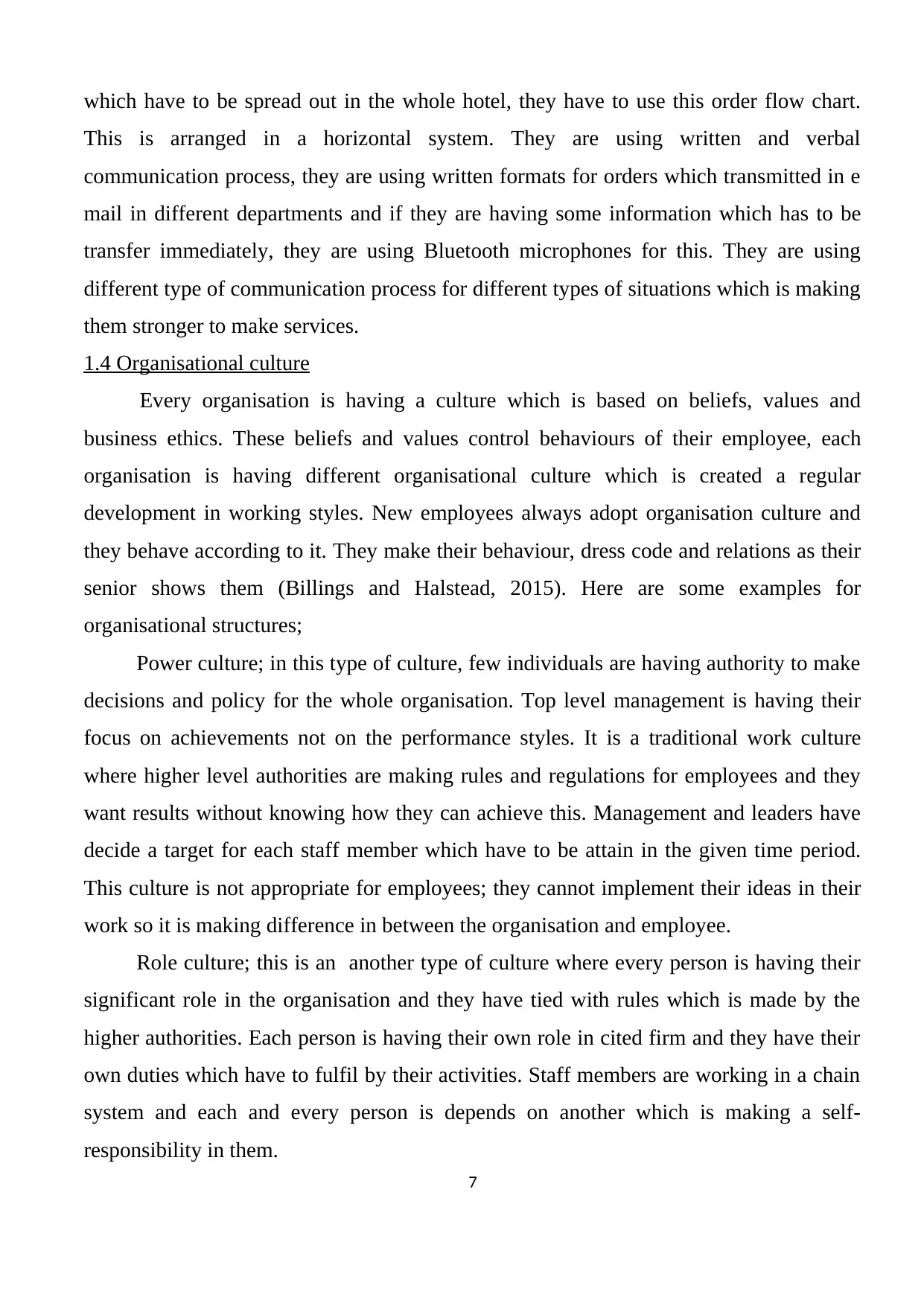
which have to be spread out in the whole hotel, they have to use this order flow chart.
This is arranged in a horizontal system. They are using written and verbal
communication process, they are using written formats for orders which transmitted in e
mail in different departments and if they are having some information which has to be
transfer immediately, they are using Bluetooth microphones for this. They are using
different type of communication process for different types of situations which is making
them stronger to make services.
1.4 Organisational culture
Every organisation is having a culture which is based on beliefs, values and
business ethics. These beliefs and values control behaviours of their employee, each
organisation is having different organisational culture which is created a regular
development in working styles. New employees always adopt organisation culture and
they behave according to it. They make their behaviour, dress code and relations as their
senior shows them (Billings and Halstead, 2015). Here are some examples for
organisational structures;
Power culture; in this type of culture, few individuals are having authority to make
decisions and policy for the whole organisation. Top level management is having their
focus on achievements not on the performance styles. It is a traditional work culture
where higher level authorities are making rules and regulations for employees and they
want results without knowing how they can achieve this. Management and leaders have
decide a target for each staff member which have to be attain in the given time period.
This culture is not appropriate for employees; they cannot implement their ideas in their
work so it is making difference in between the organisation and employee.
Role culture; this is an another type of culture where every person is having their
significant role in the organisation and they have tied with rules which is made by the
higher authorities. Each person is having their own role in cited firm and they have their
own duties which have to fulfil by their activities. Staff members are working in a chain
system and each and every person is depends on another which is making a self-
responsibility in them.
7
This is arranged in a horizontal system. They are using written and verbal
communication process, they are using written formats for orders which transmitted in e
mail in different departments and if they are having some information which has to be
transfer immediately, they are using Bluetooth microphones for this. They are using
different type of communication process for different types of situations which is making
them stronger to make services.
1.4 Organisational culture
Every organisation is having a culture which is based on beliefs, values and
business ethics. These beliefs and values control behaviours of their employee, each
organisation is having different organisational culture which is created a regular
development in working styles. New employees always adopt organisation culture and
they behave according to it. They make their behaviour, dress code and relations as their
senior shows them (Billings and Halstead, 2015). Here are some examples for
organisational structures;
Power culture; in this type of culture, few individuals are having authority to make
decisions and policy for the whole organisation. Top level management is having their
focus on achievements not on the performance styles. It is a traditional work culture
where higher level authorities are making rules and regulations for employees and they
want results without knowing how they can achieve this. Management and leaders have
decide a target for each staff member which have to be attain in the given time period.
This culture is not appropriate for employees; they cannot implement their ideas in their
work so it is making difference in between the organisation and employee.
Role culture; this is an another type of culture where every person is having their
significant role in the organisation and they have tied with rules which is made by the
higher authorities. Each person is having their own role in cited firm and they have their
own duties which have to fulfil by their activities. Staff members are working in a chain
system and each and every person is depends on another which is making a self-
responsibility in them.
7
Paraphrase This Document
Need a fresh take? Get an instant paraphrase of this document with our AI Paraphraser
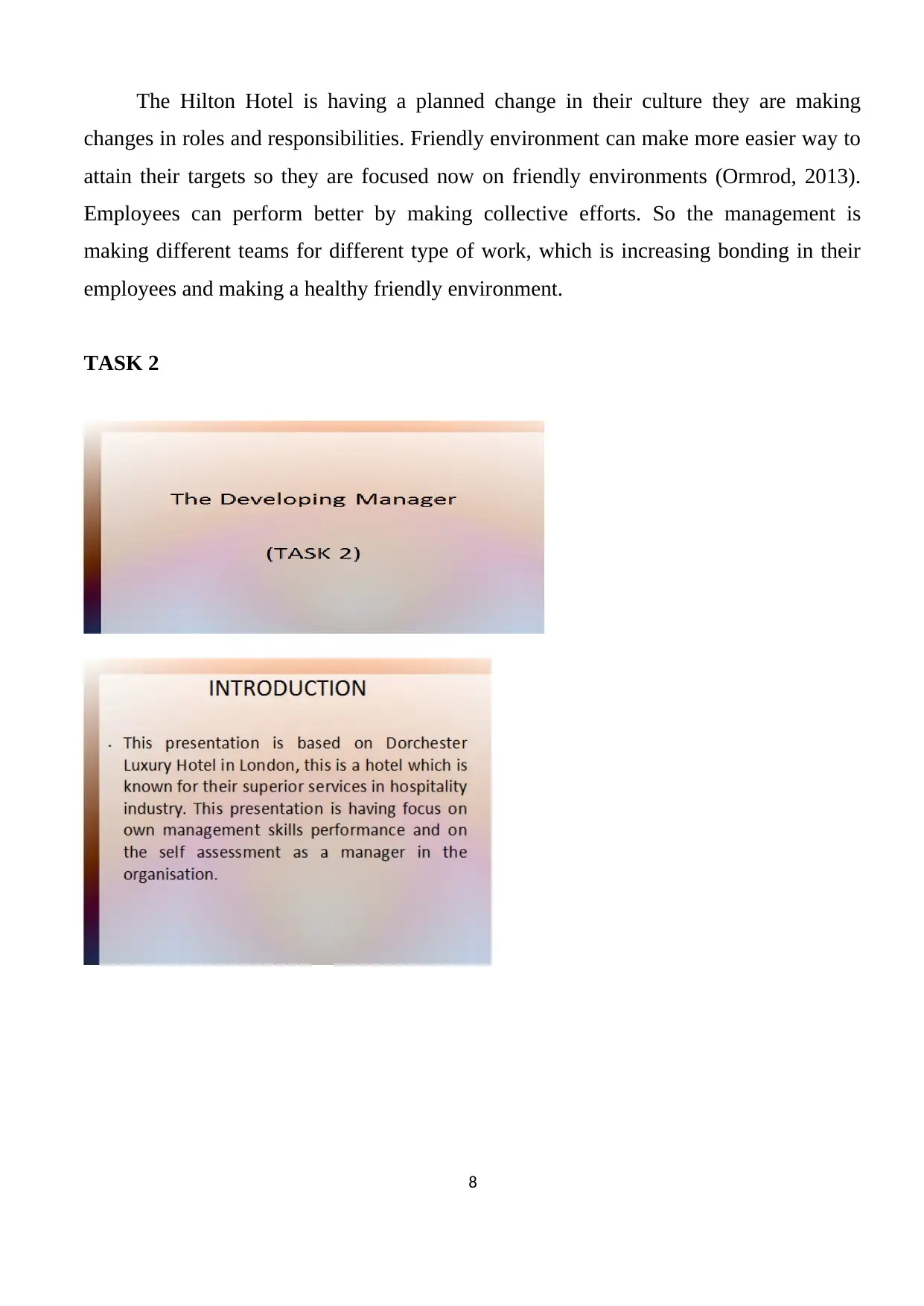
The Hilton Hotel is having a planned change in their culture they are making
changes in roles and responsibilities. Friendly environment can make more easier way to
attain their targets so they are focused now on friendly environments (Ormrod, 2013).
Employees can perform better by making collective efforts. So the management is
making different teams for different type of work, which is increasing bonding in their
employees and making a healthy friendly environment.
TASK 2
8
changes in roles and responsibilities. Friendly environment can make more easier way to
attain their targets so they are focused now on friendly environments (Ormrod, 2013).
Employees can perform better by making collective efforts. So the management is
making different teams for different type of work, which is increasing bonding in their
employees and making a healthy friendly environment.
TASK 2
8
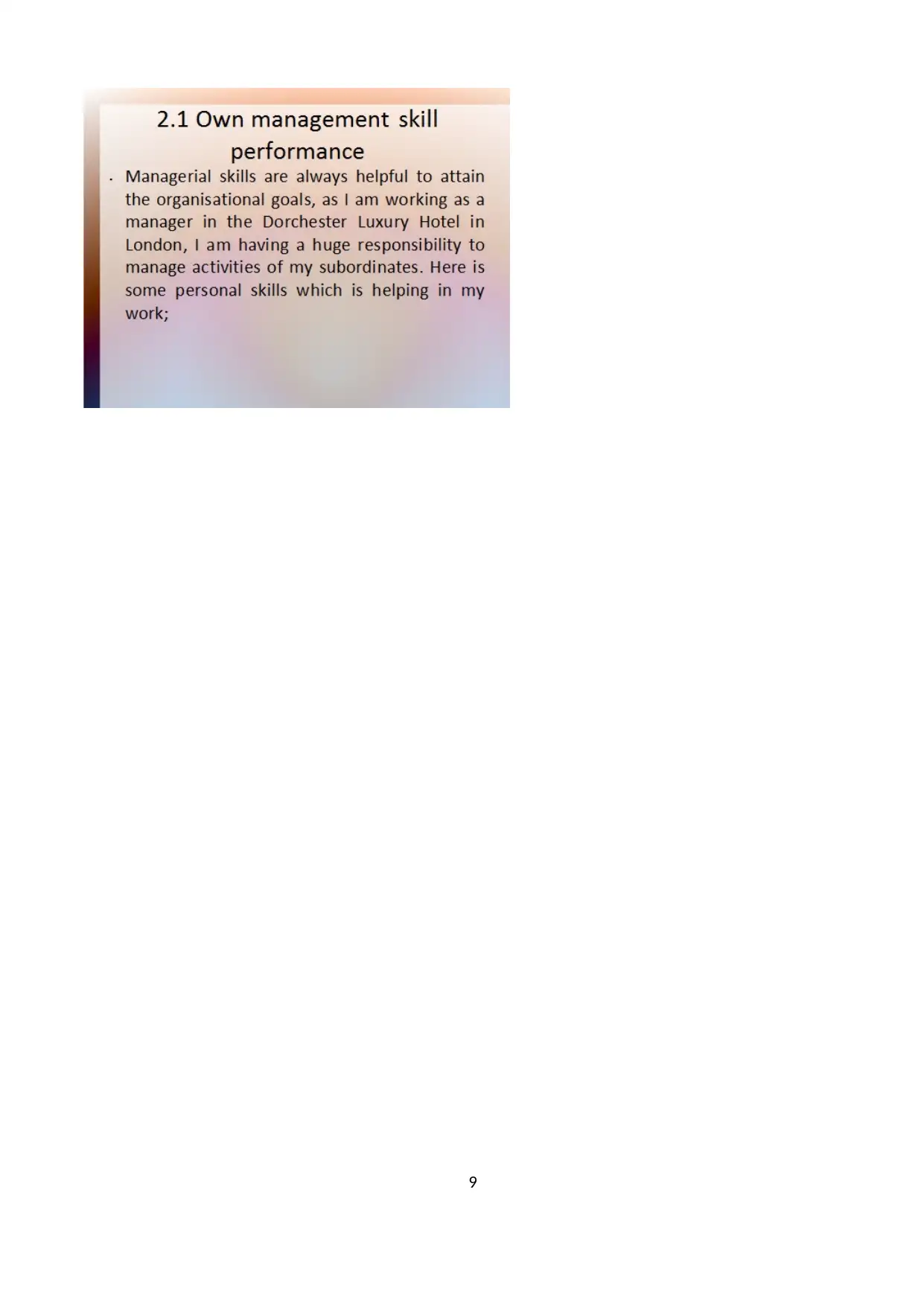
9
⊘ This is a preview!⊘
Do you want full access?
Subscribe today to unlock all pages.

Trusted by 1+ million students worldwide
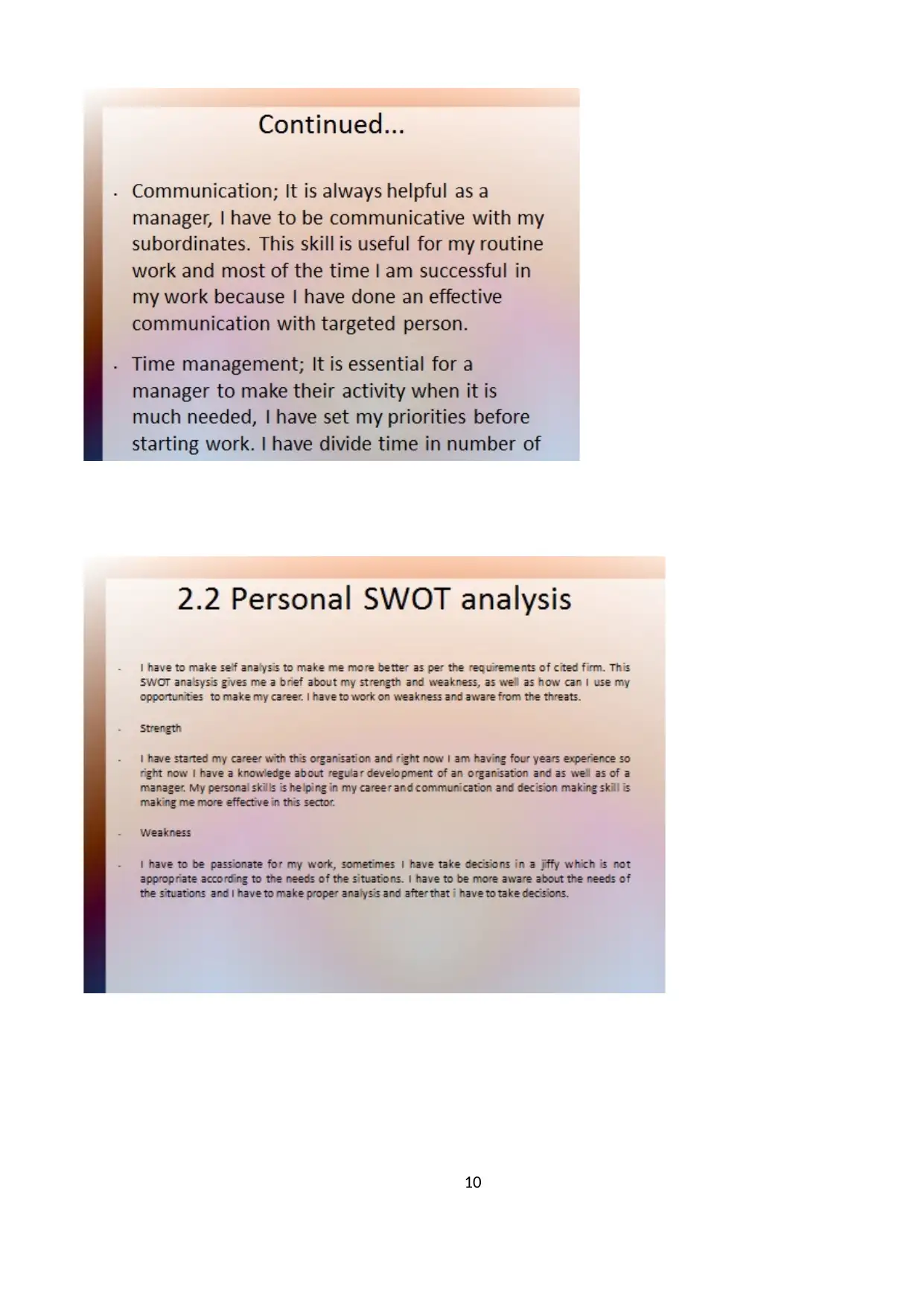
10
Paraphrase This Document
Need a fresh take? Get an instant paraphrase of this document with our AI Paraphraser
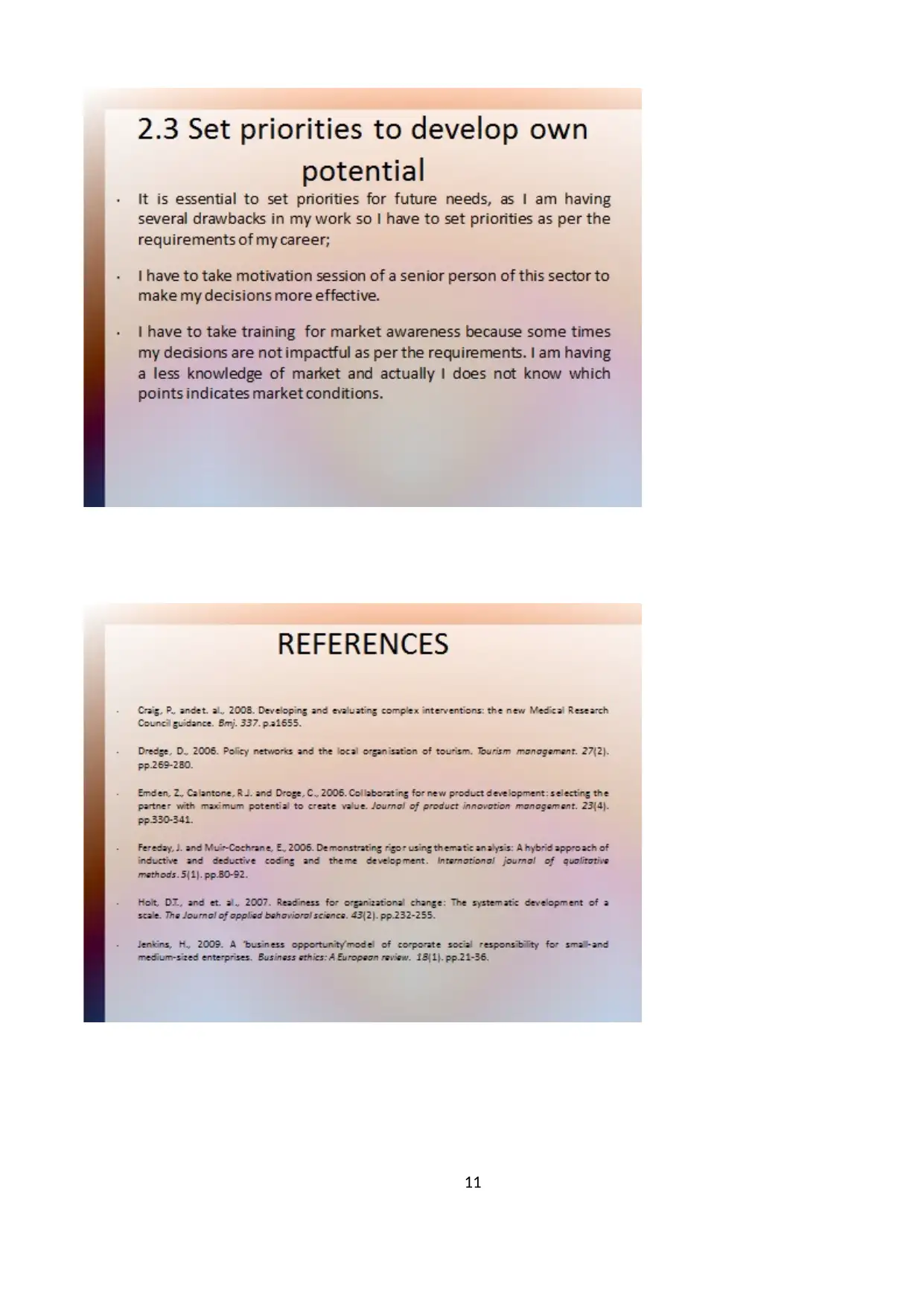
11
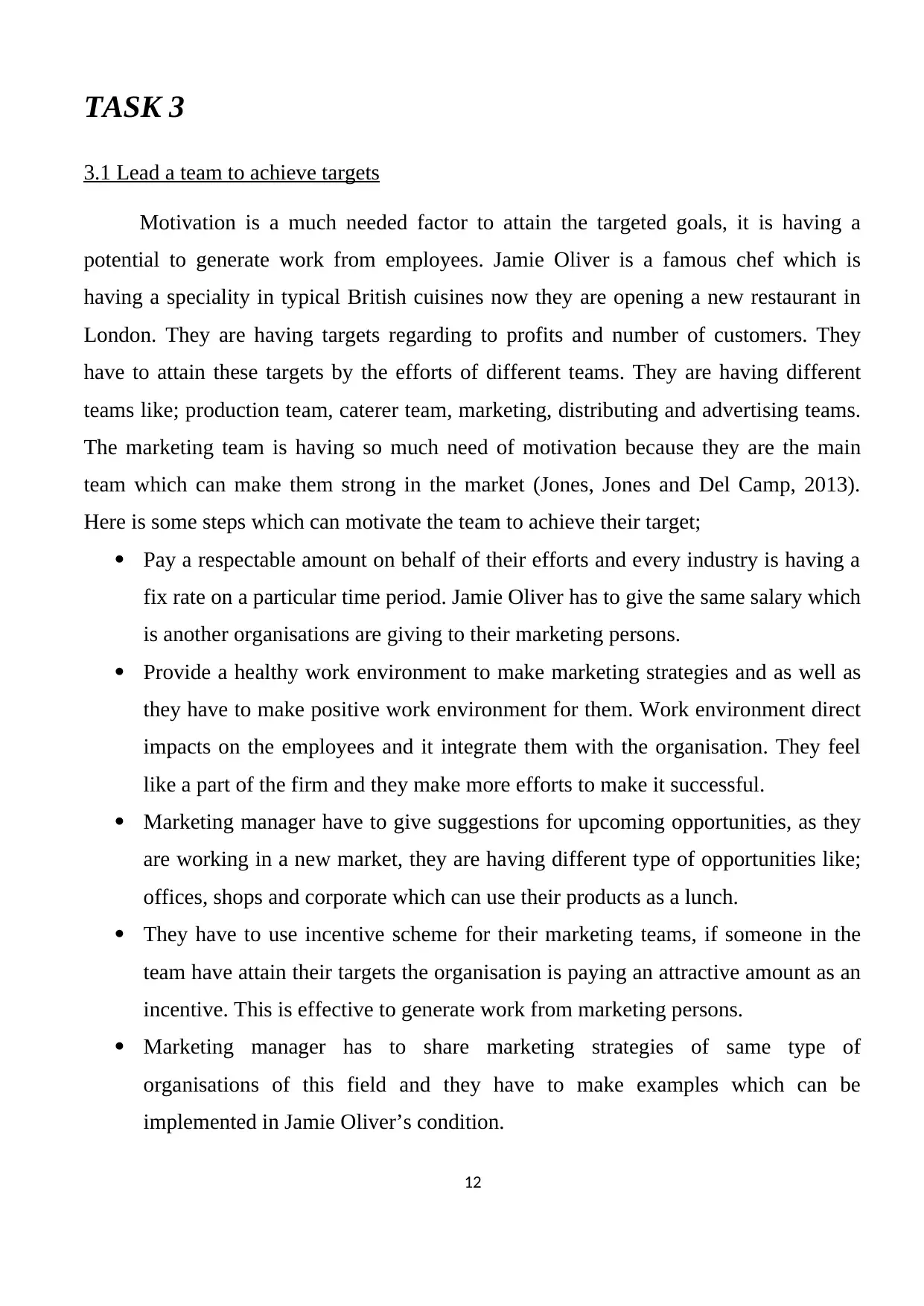
TASK 3
3.1 Lead a team to achieve targets
Motivation is a much needed factor to attain the targeted goals, it is having a
potential to generate work from employees. Jamie Oliver is a famous chef which is
having a speciality in typical British cuisines now they are opening a new restaurant in
London. They are having targets regarding to profits and number of customers. They
have to attain these targets by the efforts of different teams. They are having different
teams like; production team, caterer team, marketing, distributing and advertising teams.
The marketing team is having so much need of motivation because they are the main
team which can make them strong in the market (Jones, Jones and Del Camp, 2013).
Here is some steps which can motivate the team to achieve their target;
Pay a respectable amount on behalf of their efforts and every industry is having a
fix rate on a particular time period. Jamie Oliver has to give the same salary which
is another organisations are giving to their marketing persons.
Provide a healthy work environment to make marketing strategies and as well as
they have to make positive work environment for them. Work environment direct
impacts on the employees and it integrate them with the organisation. They feel
like a part of the firm and they make more efforts to make it successful.
Marketing manager have to give suggestions for upcoming opportunities, as they
are working in a new market, they are having different type of opportunities like;
offices, shops and corporate which can use their products as a lunch.
They have to use incentive scheme for their marketing teams, if someone in the
team have attain their targets the organisation is paying an attractive amount as an
incentive. This is effective to generate work from marketing persons.
Marketing manager has to share marketing strategies of same type of
organisations of this field and they have to make examples which can be
implemented in Jamie Oliver’s condition.
12
3.1 Lead a team to achieve targets
Motivation is a much needed factor to attain the targeted goals, it is having a
potential to generate work from employees. Jamie Oliver is a famous chef which is
having a speciality in typical British cuisines now they are opening a new restaurant in
London. They are having targets regarding to profits and number of customers. They
have to attain these targets by the efforts of different teams. They are having different
teams like; production team, caterer team, marketing, distributing and advertising teams.
The marketing team is having so much need of motivation because they are the main
team which can make them strong in the market (Jones, Jones and Del Camp, 2013).
Here is some steps which can motivate the team to achieve their target;
Pay a respectable amount on behalf of their efforts and every industry is having a
fix rate on a particular time period. Jamie Oliver has to give the same salary which
is another organisations are giving to their marketing persons.
Provide a healthy work environment to make marketing strategies and as well as
they have to make positive work environment for them. Work environment direct
impacts on the employees and it integrate them with the organisation. They feel
like a part of the firm and they make more efforts to make it successful.
Marketing manager have to give suggestions for upcoming opportunities, as they
are working in a new market, they are having different type of opportunities like;
offices, shops and corporate which can use their products as a lunch.
They have to use incentive scheme for their marketing teams, if someone in the
team have attain their targets the organisation is paying an attractive amount as an
incentive. This is effective to generate work from marketing persons.
Marketing manager has to share marketing strategies of same type of
organisations of this field and they have to make examples which can be
implemented in Jamie Oliver’s condition.
12
⊘ This is a preview!⊘
Do you want full access?
Subscribe today to unlock all pages.

Trusted by 1+ million students worldwide
1 out of 20
Related Documents
Your All-in-One AI-Powered Toolkit for Academic Success.
+13062052269
info@desklib.com
Available 24*7 on WhatsApp / Email
![[object Object]](/_next/static/media/star-bottom.7253800d.svg)
Unlock your academic potential
Copyright © 2020–2025 A2Z Services. All Rights Reserved. Developed and managed by ZUCOL.





